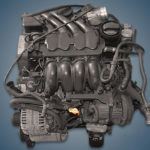The 1.8-liter Audi APG 20v gasoline engine was assembled by the company from 2000 to 2005 and installed on the restyled version of the first generation A3 and some Seat models. This power unit, in fact, was a slightly updated version of the AGN engine in terms of ecology.
The EA113-1.8 series includes: AGN, APG.
Specifications
| Production years | 2000-2005 |
| Displacement, cc | 1781 |
| Fuel system | injector |
| Power output, hp | 125 |
| Torque output, Nm | 170 |
| Cylinder block | cast iron R4 |
| Block head | aluminum 20v |
| Cylinder bore, mm | 81 |
| Piston stroke, mm | 86.4 |
| Compression ratio | 10.3 |
| Features | DOHC |
| Hydraulic lifters | yes |
| Timing drive | chain & belt |
| Phase regulator | no |
| Turbocharging | no |
| Recommended engine oil | 5W-30 |
| Engine oil capacity, liter | 4.5 |
| Fuel type | petrol |
| Euro standards | EURO 3 |
| Fuel consumption, L/100 km (for Audi A3 2002) — city — highway — combined |
10.6 6.2 7.8 |
| Engine lifespan, km | ~350 000 |
The engine was installed on:
- Audi A3 1 (8L) in 2000 – 2003;
- Seat Leon 1 (1M) in 2000 – 2005;
- Seat Toledo 2 (1M) in 2000 – 2004.
Disadvantages of the Audi APG engine
- A simple and reliable power unit rarely worries its owners.
- The culprit of the floating engine speed is the contamination of the injectors or throttle.
- Also, the vacuum regulator of the intake manifold flaps intermittently sticks.
- In terms of electrics, lambda probes, a coolant temperature sensor, and a mass air flow sensor most often fail here.
- A capricious crankcase ventilation system can throw a lot of problems.






